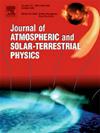Performance analysis of IRI-2016 and IRI-2020 models, and GPS and GLONASS-TEC variations, and their predictions using Artificial Neural Networks (ANNs) at low latitude station Agra, India
IF 1.8
4区 地球科学
Q3 GEOCHEMISTRY & GEOPHYSICS
Journal of Atmospheric and Solar-Terrestrial Physics
Pub Date : 2025-02-01
DOI:10.1016/j.jastp.2024.106412
引用次数: 0
Abstract
The total electron content (TEC) data was collected using the newly installed receiver namely GPStation6 at the Agra, India station in 2016. The TEC data for Global Positioning System (GPS) and GLONASS navigation systems and the IRI-2020 and IRI-2016 models were statistically processed diurnally, monthly, seasonally, and yearly during the descending phase of solar activity in 2018. The entropy of the TEC variations was calculated to assess the chaotic behaviour of the data. Subsequently, the observed results were predicted using artificial neural networks (ANNs). The highest TEC values for GPS, GLONASS, and both IRI models were recorded in April (≈50 TECU and 35 TECU), whereas the lowest values were recorded in November and December (≈20–25 and 15–20 TECU). In terms of seasonal values, GPS and GLONASS-TEC were underestimated by the IRI models. The maximum seasonal TEC values (≈45 TECU) were recorded for GLONASS in the equinox, ≈35 TECU for GPS in the summer, and ≈30 TECU for both IRI models in the equinox, while the minimum TEC values were recorded in winter for GPS (≈30 TECU), GLONASS (≈35 TECU), and IRI models (≈25 TECU). A strong correlation was observed between TEC variations and IRI models. A weaker and negative correlation between magnetic storm activity (∑Kp) and observed TEC variations was observed, whereas a weaker and positive correlation was found between TEC and solar activity (F10.7). The entropy values were higher for GPS-TEC than for GLONASS-TEC. These variations were interpreted based on literature published by previous researchers.
印度阿格拉低纬度站GPS和GLONASS-TEC变化对iris -2016和iris -2020模型的性能分析及其人工神经网络预测
总电子含量(TEC)数据于2016年在印度阿格拉站使用新安装的接收器GPStation6收集。对2018年太阳活动下降期全球定位系统(GPS)和GLONASS导航系统的TEC数据以及IRI-2020和IRI-2016模型进行日、月、季、年统计处理。计算TEC变化的熵来评估数据的混沌行为。随后,利用人工神经网络(ann)对观测结果进行预测。GPS、GLONASS和两个IRI模式的TEC值在4月最高(≈50 TECU和35 TECU), 11月和12月最低(≈20-25和15-20 TECU)。就季节值而言,IRI模型低估了GPS和GLONASS-TEC。GLONASS模式的TEC值在春分时最大(≈45 TECU), GPS模式在夏季≈35 TECU, IRI模式在春分时最大(≈30 TECU),而GPS模式、GLONASS模式和IRI模式的TEC值在冬季最小(≈30 TECU),而IRI模式的TEC值在冬季最小(≈25 TECU)。在TEC变化和IRI模型之间观察到很强的相关性。磁暴活动(∑Kp)与观测到的TEC变化呈较弱的负相关,而TEC与太阳活动呈较弱的正相关(F10.7)。GPS-TEC的熵值高于GLONASS-TEC。这些差异是根据先前研究人员发表的文献来解释的。
本文章由计算机程序翻译,如有差异,请以英文原文为准。
求助全文
约1分钟内获得全文
求助全文
来源期刊

Journal of Atmospheric and Solar-Terrestrial Physics
地学-地球化学与地球物理
CiteScore
4.10
自引率
5.30%
发文量
95
审稿时长
6 months
期刊介绍:
The Journal of Atmospheric and Solar-Terrestrial Physics (JASTP) is an international journal concerned with the inter-disciplinary science of the Earth''s atmospheric and space environment, especially the highly varied and highly variable physical phenomena that occur in this natural laboratory and the processes that couple them.
The journal covers the physical processes operating in the troposphere, stratosphere, mesosphere, thermosphere, ionosphere, magnetosphere, the Sun, interplanetary medium, and heliosphere. Phenomena occurring in other "spheres", solar influences on climate, and supporting laboratory measurements are also considered. The journal deals especially with the coupling between the different regions.
Solar flares, coronal mass ejections, and other energetic events on the Sun create interesting and important perturbations in the near-Earth space environment. The physics of such "space weather" is central to the Journal of Atmospheric and Solar-Terrestrial Physics and the journal welcomes papers that lead in the direction of a predictive understanding of the coupled system. Regarding the upper atmosphere, the subjects of aeronomy, geomagnetism and geoelectricity, auroral phenomena, radio wave propagation, and plasma instabilities, are examples within the broad field of solar-terrestrial physics which emphasise the energy exchange between the solar wind, the magnetospheric and ionospheric plasmas, and the neutral gas. In the lower atmosphere, topics covered range from mesoscale to global scale dynamics, to atmospheric electricity, lightning and its effects, and to anthropogenic changes.
 求助内容:
求助内容: 应助结果提醒方式:
应助结果提醒方式:


